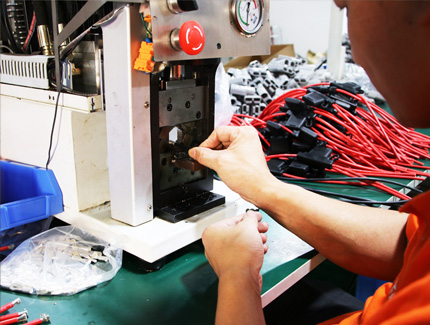Terminal crimping is a technology invented by Amp Incorporated in 1941, which is a solder-free method used for terminating wires and connectors. Compared to soldering, crimping technology can terminate wiring faster and more consistently. Over the years, many different crimping methods have been invented for single wires, multiple wires, and coaxial cables.
Most people think of "crimping" as simply pressing a contact onto a wire, providing conductivity through pressure. However, true crimping involves the "elastic" and "plastic" deformation of metal, resulting in "cold welding." The "contact rough welding" on the metal surface mechanically cleans the wires and connectors during deformation, often without the need to pre-clean the wires and terminals. When done correctly, this crimping connection can be stronger and more durable than soldered connections, with resistance equal to the length of the wire. Proper crimping is also airtight, preventing oxidation from degrading over time.

Connector Terminal Crimp Schematic
There are certain key factors in the crimping process that are necessary to create proper cold welding crimp connections, including ideal connectors that interact with wires and insulation material support. Properly completing all of these operations will result in highly electrical performance and durable terminations, with excellent durability in harsh environments.
First and foremost, it is essential to understand that all connectors can work within a small range of wire diameters. Using incorrectly sized wires and connectors can lead to poor electrical performance, mechanical strength, and often result in poor or nonexistent material cold welding. In addition to matching connectors to wires or cables, proper crimping of terminals, using the right tools under the right conditions, is absolutely necessary, as both wire contact and tool design must be very precise.
Measurements of the crimped contact must be taken with extreme accuracy, typically within thousandths of an inch or smaller. Amplification is also necessary to view the crimping to ensure that tool wear or contamination does not adversely affect the quality of the crimped terminals. Even slight wear or contamination on the crimping die can result in poor crimping. As there are various types of crimps, different on-site testing methods must be employed to ensure proper material displacement during the crimping process.
A portion of the terminal is crimped, and then the "crimp height" is taken. The crimp height of the terminal will vary with the wire size of different terminal designs. The crimp height is specified by the terminal and tool manufacturer and should provide several sizes of terminal types to fit different wire sizes. These tools of different contact sizes also vary, although the most common method is the "modular" SEDroach to crimping "crimpers," especially for automatic or semi-automatic machines, different sizes of actual "dies" have unique sizes and shapes due to compatibility with contact designs and wire sizes.
Other types of crimps have other necessary measurements to determine if the crimping machine and tool are set correctly. For example, the insertion depth of the wire in IDC connectors is measured by using a dial gauge to measure the crimping of IDC (Insulation Displacement Crimp) connectors. For all types of crimps, it is essential to measure whether the crimping is within specification to ensure proper cold welding and airtight crimping.
One often overlooked feature of most crimps is insulation support crimping, where the crimped portion of the terminal should not come into contact with the wire. The insulation crimping there provides strain relief and vibration resistance for the wire crimping. Without stress relief or stress relief, poor crimping will affect the wire crimping directly due to vibration or repeated bending of the wire, ultimately leading to breakage. For reasons of speed, cost, and repeatability, crimping is the most commonly used type of wire-to-connector connection in electronic products to date. Proper crimping will form a weld between the wire and the contact, resulting in an extremely reliable, durable connection that lasts in harsh environments.
 Guangdong SED Co., Ltd.
Guangdong SED Co., Ltd.
 +86 13763213143
+86 13763213143
 info@dmictech.com
info@dmictech.com


